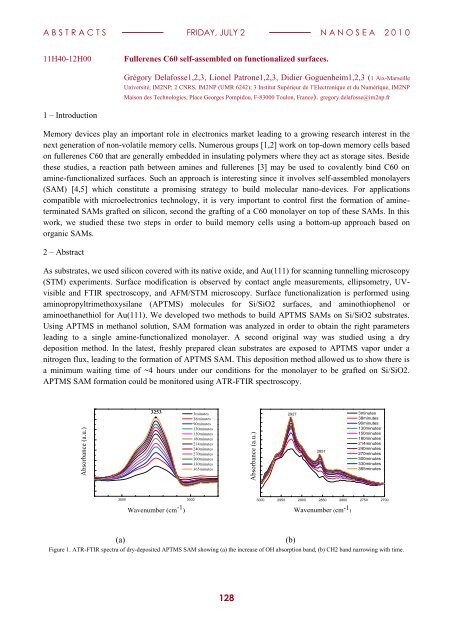book of abstracts - IM2NP
book of abstracts - IM2NP
book of abstracts - IM2NP
You also want an ePaper? Increase the reach of your titles
YUMPU automatically turns print PDFs into web optimized ePapers that Google loves.
Absorbance (a.u.)<br />
Absorbance (a.u.)<br />
A B S T R A C T S FRIDAY, JULY 2 N A N O S E A 2 0 1 0<br />
11H40-12H00<br />
Fullerenes C60 self-assembled on functionalized surfaces.<br />
Grégory Delafosse1,2,3, Lionel Patrone1,2,3, Didier Goguenheim1,2,3 (1 Aix-Marseille<br />
Université, <strong>IM2NP</strong>; 2 CNRS, <strong>IM2NP</strong> (UMR 6242); 3 Institut Supérieur de l‟Electronique et du Numérique, <strong>IM2NP</strong><br />
Maison des Technologies, Place Georges Pompidou, F-83000 Toulon, France). gregory.delafosse@im2np.fr<br />
1 – Introduction<br />
Memory devices play an important role in electronics market leading to a growing research interest in the<br />
next generation <strong>of</strong> non-volatile memory cells. Numerous groups [1,2] work on top-down memory cells based<br />
on fullerenes C60 that are generally embedded in insulating polymers where they act as storage sites. Beside<br />
these studies, a reaction path between amines and fullerenes [3] may be used to covalently bind C60 on<br />
amine-functionalized surfaces. Such an approach is interesting since it involves self-assembled monolayers<br />
(SAM) [4,5] which constitute a promising strategy to build molecular nano-devices. For applications<br />
compatible with microelectronics technology, it is very important to control first the formation <strong>of</strong> amineterminated<br />
SAMs grafted on silicon, second the grafting <strong>of</strong> a C60 monolayer on top <strong>of</strong> these SAMs. In this<br />
work, we studied these two steps in order to build memory cells using a bottom-up approach based on<br />
organic SAMs.<br />
2 – Abstract<br />
As substrates, we used silicon covered with its native oxide, and Au(111) for scanning tunnelling microscopy<br />
(STM) experiments. Surface modification is observed by contact angle measurements, ellipsometry, UVvisible<br />
and FTIR spectroscopy, and AFM/STM microscopy. Surface functionalization is performed using<br />
aminopropyltrimethoxysilane (APTMS) molecules for Si/SiO2 surfaces, and aminothiophenol or<br />
aminoethanethiol for Au(111). We developed two methods to build APTMS SAMs on Si/SiO2 substrates.<br />
Using APTMS in methanol solution, SAM formation was analyzed in order to obtain the right parameters<br />
leading to a single amine-functionalized monolayer. A second original way was studied using a dry<br />
deposition method. In the latest, freshly prepared clean substrates are exposed to APTMS vapor under a<br />
nitrogen flux, leading to the formation <strong>of</strong> APTMS SAM. This deposition method allowed us to show there is<br />
a minimum waiting time <strong>of</strong> ~4 hours under our conditions for the monolayer to be grafted on Si/SiO2.<br />
APTMS SAM formation could be monitored using ATR-FTIR spectroscopy.<br />
3253<br />
3minutes<br />
38minutes<br />
90minutes<br />
130minutes<br />
150minutes<br />
180minutes<br />
214minutes<br />
240minutes<br />
270minutes<br />
300minutes<br />
330minutes<br />
365minutes<br />
2927<br />
2857<br />
3minutes<br />
38minutes<br />
90minutes<br />
130minutes<br />
150minutes<br />
180minutes<br />
214minutes<br />
240minutes<br />
270minutes<br />
300minutes<br />
330minutes<br />
365minutes<br />
3500 3000<br />
Wavenumber (cm -1 )<br />
3000 2950 2900 2850 2800 2750 2700<br />
Wavenumber (cm -1 )<br />
(a)<br />
Figure 1. ATR-FTIR spectra <strong>of</strong> dry-deposited APTMS SAM showing (a) the increase <strong>of</strong> OH absorption band, (b) CH2 band narrowing with time.<br />
(b)<br />
128

















